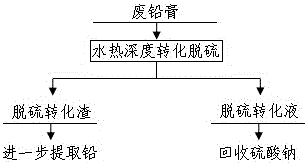Hydrothermal deep conversion desulfurization method for waste lead plaster of lead-acid storage battery
A technology of waste lead-acid batteries and waste lead paste, which is applied in the direction of improving process efficiency, can solve the problems of affecting the application effect, low reduction efficiency, difficult reagent reaction, etc., and achieves low production cost, low labor intensity and simple operation. Effect
- Summary
- Abstract
- Description
- Claims
- Application Information
AI Technical Summary
Problems solved by technology
Method used
Image
Examples
Embodiment 1
[0020]The main components of waste lead paste in the dismantling products of waste lead-acid batteries are (%) by weight percentage: Pb73.80%, S5.25% and Sb0.15%, and sodium carbonate is an analytical reagent. Add 2000g of waste lead plaster and 356g of sodium carbonate to 4000ml of water at the same time for slurrying, then add the mixed slurry into a stainless steel high-pressure reactor, keep the stirring speed at 120r / min, control the partial pressure of nitrogen to 0.3MPa and ventilate for 2min, then raise the temperature To 160°C, control the partial pressure of nitrogen to 0.8MPa to react for 3 hours. When the reaction is completed, cool down and lower the temperature to 65°C, vacuum filtration is used to achieve liquid-solid separation, the sulfur content in the desulfurization conversion residue is reduced to 0.02%, and the desulfurization rate reaches 99.40%.
Embodiment 2
[0022] The main components of waste lead paste in the dismantling products of waste lead-acid batteries are (%): Pb73.80%, S5.25% and Sb0.15%, and sodium hydroxide is an analytical reagent. Add 2000g of waste lead plaster and 268g of sodium hydroxide to 4000ml of water at the same time for slurrying, then add the mixed slurry into a stainless steel high-pressure reactor, keep the stirring speed at 120r / min, control the partial pressure of nitrogen to 0.3MPa and ventilate for 2min, then increase Temperature to 180°C, control nitrogen partial pressure 0.8MPa to react for 3 hours, after the reaction is completed, cool down and lower the temperature to 70°C, use vacuum filtration to achieve liquid-solid separation, the sulfur content in the desulfurization conversion slag is reduced to 0.01%, and the desulfurization rate reaches 99.38% .
PUM
 Login to View More
Login to View More Abstract
Description
Claims
Application Information
 Login to View More
Login to View More - R&D
- Intellectual Property
- Life Sciences
- Materials
- Tech Scout
- Unparalleled Data Quality
- Higher Quality Content
- 60% Fewer Hallucinations
Browse by: Latest US Patents, China's latest patents, Technical Efficacy Thesaurus, Application Domain, Technology Topic, Popular Technical Reports.
© 2025 PatSnap. All rights reserved.Legal|Privacy policy|Modern Slavery Act Transparency Statement|Sitemap|About US| Contact US: help@patsnap.com

